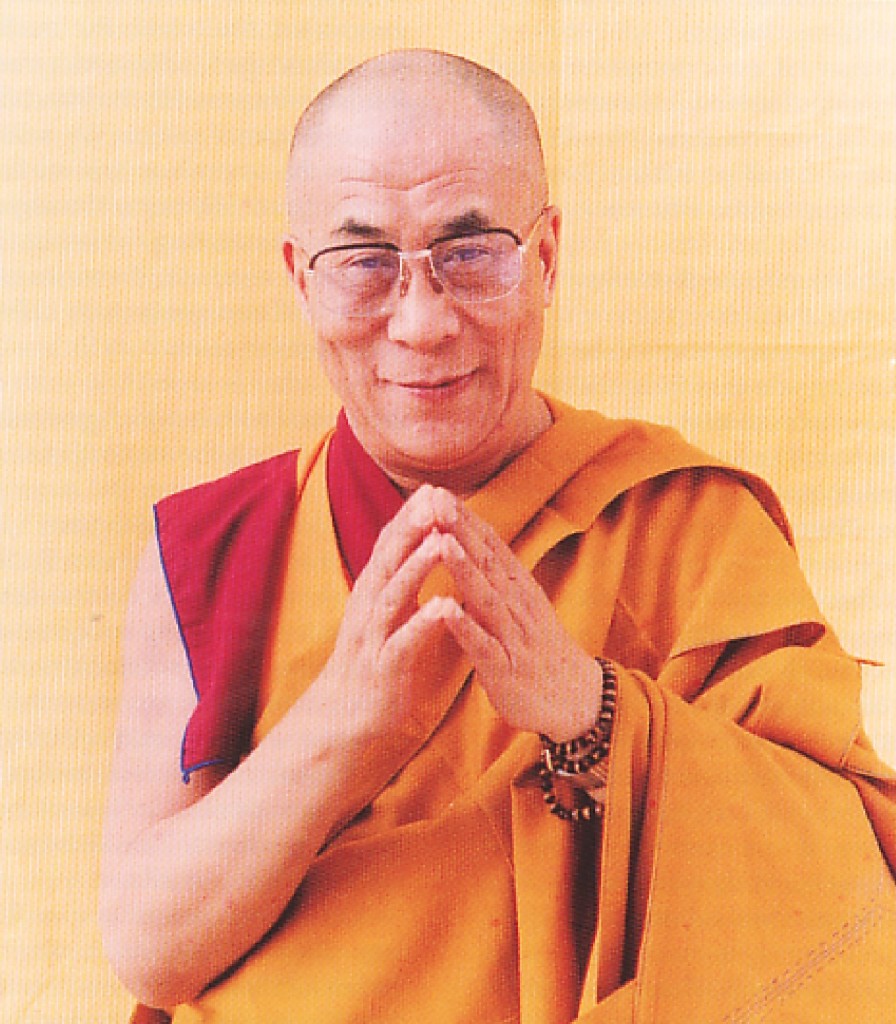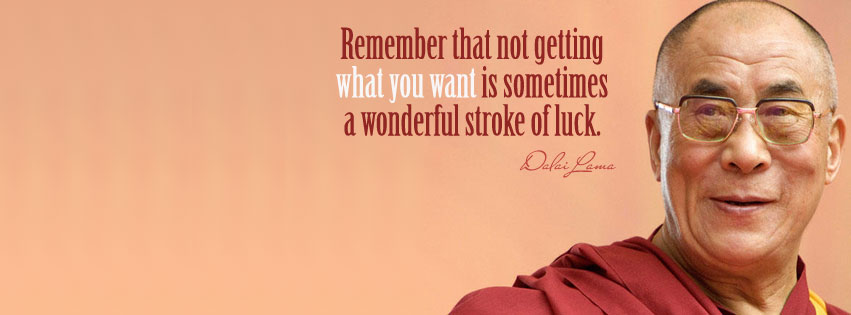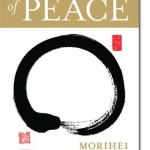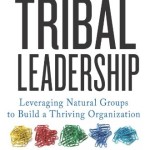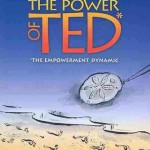[ PROFILES – ICONS ] an ongoing series on inspiring leaders
“The true hero is one
who conquers his own anger and hatred.”
The Position:
The Dalai Lama is a high lama in the Gelug or “Yellow Hat” school of Tibetan Buddhism, founded by Tsongkhapa(1357–1419). The name is a combination of the Mongolic word dalai meaning “ocean” and the Tibetan word བླ་མ་ (bla-ma) meaning “guru, teacher, mentor”.
The Dalai Lama is traditionally thought to be the rebirth in a line of tulkus who are considered to be manifestations of the bodhisattva of compassion, Avalokiteśvara. The Dalai Lama is often thought to be the leader of the Gelug School, but this position belongs officially to the Ganden Tripa, which is a temporary position appointed by the Dalai Lama who, in practice, exerts much influence. The line of Dalai Lamas began as a lineage of spiritual teachers; the 5th Dalai Lama assumed political authority over Tibet.
For certain periods between the 17th century and 1962, the Dalai Lamas sometimes directed the Tibetan government, which administered portions of Tibet from Lhasa. The 14th Dalai Lama remained the head of state for the Central Tibetan Administration(“Tibetan government in exile”) until his retirement on March 14, 2011. He has indicated that the institution of the Dalai Lama may be abolished in the future, and also that the next Dalai Lama may be found outside Tibet and may be female. The Chinese government rejected this and asserted that only it has the authority to select the next Dalai Lama. [From: Wikipedia.com]
“Be kind whenever possible.
It is always possible.”
The Person:
His Holiness the 14th Dalai Lama, Tenzin Gyatso, describes himself as a simple Buddhist monk. He is the spiritual leader of Tibet. He was born on 6 July 1935, to a farming family, in a small hamlet located in Taktser, Amdo, northeastern Tibet. At the very young age of two, the child who was named Lhamo Dhondup at that time, was recognized as the reincarnation of the previous 13th Dalai Lama, Thubten Gyatso.
The Dalai Lamas are believed to be manifestations of Avalokiteshvara or Chenrezig, the Bodhisattva of Compassion and the patron saint of Tibet. Bodhisattvas are believed to be enlightened beings who have postponed their own nirvana and chosen to take rebirth in order to serve humanity.
Education in Tibet
His Holiness began his monastic education at the age of six. The curriculum consisted of five major and five minor subjects. The major subjects were logic, Tibetan art and culture, Sanskrit, medicine, and Buddhist philosophy which was further divided into a further five categories: Prajnaparimita, the perfection of wisdom; Madhyamika, the philosophy of the middle Way; Vinaya, the canon of monastic discipline; Abidharma, metaphysics; and Pramana, logic and epistemology. The five minor subjects were poetry, music and drama, astrology, composition and phrasing, and synonyms. At 23, His Holiness sat for his final examination in Lhasa’s Jokhang Temple, during the annual Monlam (prayer) Festival in 1959. He passed with honors and was awarded the Geshe Lharampa degree, the highest-level degree, equivalent to a doctorate of Buddhist philosophy.
Leadership Responsibilities
In 1950 His Holiness was called upon to assume full political power after China’s invasion of Tibet in 1949/50. In 1954, he went to Beijing for peace talks with Mao Zedong and other Chinese leaders, including Deng Xiaoping and Chou Enlai. But finally, in 1959, with the brutal suppression of the Tibetan national uprising in Lhasa by Chinese troops, His Holiness was forced to escape into exile. Since then he has been living in Dharamsala, northern India.
Since the Chinese invasion, the Central Tibetan Administration led by His Holiness appealed to the United Nations on the question of Tibet. The General Assembly adopted three resolutions on Tibet in 1959, 1961 and 1965.
“A good friend who points out mistakes and imperfections and rebukes evil is to be respected as if he reveals the secret of some hidden treasure.”
Democratization Process
In 1963, His Holiness presented a draft democratic constitution for Tibet that was followed by a number of reforms to democratize the Tibetan administrative set-up. The new democratic constitution promulgated as a result of this reform was named “The Charter of Tibetans in Exile”. The charter enshrines freedom of speech, belief, assembly and movement. It also provides detailed guidelines on the functioning of the Tibetan Administration with respect to those living in exile.
In 1992, the Central Tibetan Administration issued guidelines for the constitution of a future, free Tibet. The guidelines outlined that when Tibet became free the immediate task would be to set up an interim government whose first responsibility will be to elect a constitutional assembly to frame and adopt Tibet’s democratic constitution. His Holiness also stated that he hoped that Tibet, comprising of the three traditional provinces of U-Tsang, Amdo and Kham, would be federal and democratic.
In May 1990, the reforms called for by His Holiness saw the realization of a truly democratic administration in exile for the Tibetan community. The Tibetan Cabinet (Kashag), which till then had been appointed by His Holiness, was dissolved along with the Tenth Assembly of the Tibetan People’s Deputies (Tibetan parliament in exile). In the same year, exile Tibetans on the Indian sub-continent and in more than 33 other countries elected 46 members to the expanded Eleventh Tibetan Assembly on a one-man one-vote basis. The Assembly, in its turn, elected the new members of the cabinet.
In September 2001, a further major step in democratization was taken when the Tibetan electorate directly elected the Kalon Tripa, the senior-most minister of the Cabinet. The Kalon Tripa in turn appointed his own cabinet who had to be approved by the Tibetan Assembly. In Tibet’s long history, this was the first time that the people elected the political leadership of Tibet. Since the direct election of the Kalon Tripa, the system of the institution of Gaden Phodrang of the Dalai Lama as both the spiritual and temporal authority ended. Since then, His Holiness described himself as being semi-retired.
Peace Initiatives
On 21 September 1987 in his address to members of the United States Congress in Washington, DC, His Holiness proposed a Five-Point Peace Plan for Tibet as the first step towards a peaceful solution to the worsening situation in Tibet. The peace plan contained five basic components:
-
Transformation of the whole of Tibet into a zone of peace.
-
Abandonment of China’s population transfer policy that threatens the very existence of the Tibetans as a people.
-
Respect for the Tibetan people’s fundamental human rights and democratic freedoms.
-
Restoration and protection of Tibet’s natural environment and the abandonment of China’s use of Tibet for the production of nuclear weapons and dumping of nuclear waste.
-
Commencement of earnest negotiations on the future status of Tibet and of relations between the Tibetan and Chinese peoples.
“Hard times build determination and inner strength.
Through them we can also come to appreciate the uselessness of anger.
Instead of getting angry nurture a deep caring and respect for troublemakers because by creating such trying circumstances they provide us with invaluable opportunities to practice tolerance and patience.”
On 15 June 1988 in an address to members of the European Parliament in Strasbourg, His Holiness made another detailed proposal elaborating on the last point of the Five-Point Peace Plan. He proposed talks between the Chinese and Tibetans leading to a self-governing democratic political entity for all three provinces of Tibet. This entity would be in association with the People’s Republic of China and the Chinese Government would continue to remain responsible for Tibet’s foreign policy and defence.
Universal Recognition
His Holiness the Dalai Lama is a man of peace. In 1989 he was awarded the Nobel Peace Prize for his non-violent struggle for the liberation of Tibet. He has consistently advocated policies of non-violence, even in the face of extreme aggression. He also became the first Nobel Laureate to be recognized for his concern for global environmental problems.
His Holiness has travelled to more than 67 countries spanning 6 continents. He has received over 150 awards, honorary doctorates, prizes, etc., in recognition of his message of peace, non-violence, inter-religious understanding, universal responsibility and compassion. He has also authored or co-authored more than 110 books.
His Holiness has held dialogues with heads of different religions and participated in many events promoting inter-religious harmony and understanding.
Since the mid-1980’s, His Holiness has begun a dialogue with modern scientists, mainly in the fields of psychology, neurobiology, quantum physics and cosmology. This has led to a historic collaboration between Buddhist monks and world-renowned scientists in trying to help individuals achieve peace of mind. This has also led to the introduction of modern science in the traditional curriculum of Tibetan monastic institutions re-established in exile.
Political Retirement
On 14 March 2011 His Holiness sent a letter to the Assembly of Tibetan People’s Deputies (Tibetan Parliament in exile) requesting them to devolve him of his temporal (political) power. According to The Charter of the Tibetans in Exile, His Holiness was technically still considered to be the head of state. The historic announcement would bring an end to the dual spiritual and political authority of the Dalai Lama and revert to the previous tradition of the first four Dalai Lamas being only the spiritual leader of Tibet. The democratically elected leadership would assume complete formal political leadership of Tibet. The Ganden Phodrang, the institution of the Dalai Lamas, would continue and remain intact.
On 29 May 2011 His Holiness signed into law the formal transfer of his temporal power to the democratically elected leader. This brought to an end the 368-year old tradition of the Dalai Lamas being both spiritual and temporal head of Tibet.
The Future
As far back as 1969, His Holiness has made clear that concerned people should decide whether the Dalai Lama’s reincarnations should continue in the future. However, in the absence of clear guidelines, should the concerned public express a strong wish for the Dalai Lamas to continue, there is an obvious risk of vested political interests misusing the reincarnation system to fulfill their own political agenda. Therefore, on 24 September 2011, clear guidelines were drawn up to recognize the next Dalai Lama, so that there is no room for doubt or deception.
His Holiness has stated that when he is about ninety he will consult the high Lamas of the Tibetan Buddhist traditions, the Tibetan public, and other concerned people who follow Tibetan Buddhism, and re-evaluate whether the institution of the Dalai Lama should continue or not. On that basis, a decision will be made. If it is decided that the reincarnation of the Dalai Lama should continue and there is a need for the Fifteenth Dalai Lama to be recognized, responsibility for doing so will primarily rest on the concerned officers of the Dalai Lama’s Gaden Phodrang Trust. They should consult the various heads of the Tibetan Buddhist traditions and the reliable oath-bound Dharma Protectors who are linked inseparably to the lineage of the Dalai Lamas. They should seek advice and direction from these concerned beings and carry out the procedures of search and recognition in accordance with past tradition. His Holiness would leave clear written instructions about this. Bear in mind that, apart from the reincarnation recognized through such legitimate methods, no recognition or acceptance should be given to a candidate chosen for political ends by anyone, including those in the People’s Republic of China.
“Where ignorance is our master, there is no possibility of real peace.”
His Holiness the Dalai Lama gives teachings throughout the year at various times and in different places. His Holiness also gives public talks. In India, teachings and public talks are usually free and open to the public. However, to attend teachings and public talks outside of India one usually is required to purchase a ticket. The proceeds from the ticket sales are used to cover the costs of the venue and other expenses related to His Holiness’s visit.
On the 16th day of the first month of the Tibetan calendar (which usually falls sometime in February or March) His Holiness gives his annual spring teachings (also called Monlam teachings) at the Main Temple in Dharamsala. These teachings usually last for a period of 15 days and are officially translated into English on FM channel. Several thousand people, both Tibetan and non-Tibetan, attend these popular teachings. His Holiness also gives other shorter teachings throughout the year at different times. During the last few years, His Holiness has also been giving teachings in India at the request of various Buddhist devotees from Taiwan and Korea. These teachings are usually translated into Chinese or Korean over the public address system and into English on FM channel. During the winter months in India, His Holiness often visits Bodh Gaya or some of the Tibetan settlements located in south India where he also regularly gives teachings.
His Holiness also gives a number of empowerments and initiations throughout the year, usually coinciding with his teachings. The Kalachakra Initiation is a complex and extensive initiation, which His Holiness has given 29 times up to 2005. However, His Holiness has always stressed the importance of practitioners attending the teachings rather than the initiations or empowerments in order to allow you to better understand the philosophy of Buddhism.
His Holiness also gives a number of public talks on topics that are close to his heart. Public talks, lasting about an hour followed by a question and answer session are popular on his foreign trips and are usually sold out soon after tickets go on sale. [From: Dalailama.com]
“You must not hate those who do wrong or harmful things; but with compassion, you must do what you can to stop them — for they are harming themselves, as well as those who suffer from their actions.”
From his exile in India, the religious and political leader the Dalai Lama has since 1959 stood at the head of the nonviolent opposition to China’s occupation of Tibet.
When the Nobel Committee chose the Dalai Lama, it emphasized that he based his Buddhist peace philosophy on reverence for all living things and the idea of a universal responsibility that embraces both man and nature. It weighed heavily in the Tibetan leader’s favor that he had showed willingness to compromise and seek reconciliation despite brutal violations.
The award of the Peace Prize gave the Dalai Lama the opportunity to present a plan for the restoration of peace and human rights in Tibet. In the plan he recommended that the country be turned into an ecologically stable and demilitarized zone that might serve as a buffer between major Asian powers. The object was to set in motion serious negotiations on the future status of Tibet, but this was rejected by the Chinese government. [From: Nobelprize.org]
“If scientific analysis were conclusively to demonstrate certain claims in Buddhism to be false, then we must accept the findings of science and abandon those claims.”
Ten random facts about this world figure:
One: He was one 16 children. In her autobiography, “Dalai Lama, My Son,” Diki Tsering noted that only seven lived past infancy; three have become “lamas” or spiritual teachers.
Two: His hobbies include collecting and repairing watches.
Three: He’s no golfer, but Bill Murray’s character in “Caddyshack” (1980) claimed he once carried the man’s clubs: “So we finish the 18th, and he’s gonna stiff me. And I say, ‘Hey, Lama, hey, how about a little something, you know, for the effort, you know.’ And he says, ‘Oh, uh, there won’t be any money, but when you die, on your deathbed, you will receive total consciousness.’ So I got that goin’ for me, which is nice.”
Four: In a 1997 interview, Newsweek reported that he keeps the plastic-wrapped, preserved corpse of his favorite tutor, Ling Rinpoche seated in a room in his house. Rinpoche had died in 1983.
Five: Apple Computer used his image in its 1998 “Think Different” campaign.
Six: Shall we Tweet? As of 6 p.m. Monday, @DalaiLama had 3,996,406 followers.
Seven: A prolific writer, he has more than 100 books to his credit — including at least three published last year.
Eight: In 1992, he served as a guest editor of Vogue’s French edition.
Nine: He is godfather to Homer Gere, son of actors Richard Gere and Carey Lowell.
Ten: His other celebrity admirers include Elle Macpherson. In 2006, an argument between Macpherson and fellow model Heidi Klum — both claimed the nickname “The Body” — seemed to be headed to court. But Macpherson’s planned suit was derailed by a meeting with His Holiness. “A few people have made me stop in my tracks,” Macpherson said, “and the Dalai Lama would be one of them.” [From: Utsandiego.com]
Books (over 100)
There are a virtual library of books written by His Holiness the 14th Dalai Lama; They are too many to list here and have been listed separately HERE>
Depiction in the media
The 14th Dalai Lama has been depicted in various movies and television programs including:
- Kundun, 1997 film directed by Martin Scorsese
- Seven Years in Tibet, 1997 film starring Brad Pitt and David Thewlis
- Klovn “Dalai Lama” Season 1, Episode 4 (2005)
- Red Dwarf episode “Meltdown”” (1991)
- Kung Fu: The Legend Continues “Dragonswing II” (1994) and “Phoenix” (1996)
- Lil’ Bush: Resident of the United States “Anthem/China”
- The Simpsons episode “Simple Simpson“
“Whether one is rich or poor, educated or illiterate, religious or non-believing, man or woman, black, white, or brown, we are all the same.
Physically, emotionally, and mentally, we are all equal.We all share basic needs for food, shelter, safety, and love.
We all aspire to happiness and we all shun suffering.Each of us has hopes, worries, fears, and dreams.
Each of us wants the best for our family and loved ones.We all experience pain when we suffer loss and joy when we achieve what we seek.
On this fundamental level, religion, ethnicity, culture, and language make no difference.”
If you like this story, CLICK HERE to join the tribe of success-minded people just like you. You will love our weekly quick summaries of top stories, talks, books, movies, music and more with handy downloadable guides, cheat sheets, cliffs notes and quote books.
And, you can opt-out at any time – no strings, promise… CLICK HERE
